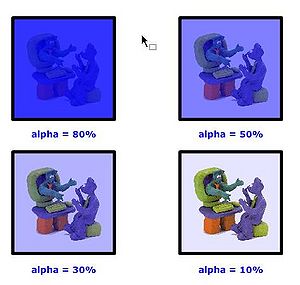Flash CS3 colors tutorial: Difference between revisions
m (using an external editor) |
m (using an external editor) |
||
| Line 69: | Line 69: | ||
* 10% good see through, but very little color | * 10% good see through, but very little color | ||
* 0% no color left | * 0% no color left | ||
[[image:flash-cs3-color-alpha-channel.jpg| | [[image:flash-cs3-color-alpha-channel.jpg|thumb|300px|none|Alpha color channel]] | ||
Revision as of 17:06, 4 September 2007
This article or section is currently under construction
In principle, someone is working on it and there should be a better version in a not so distant future.
If you want to modify this page, please discuss it with the person working on it (see the "history")
Introduction
This is part of the Flash tutorials.
- Learning goals
- Learn to deal with colors
- Prerequisites
- Flash CS3 desktop tutorial
- Flash layers tutorial
- Flash drawing tutorial (at least some of it)
- Quality and level
- This text should technical people get going. It's probably not good enough for beginners, but may be used as handout in "hands-on" class. That is what Daniel K. Schneider made it for...
- It aims at beginners. More advanced features and tricks are not explained here.
- Color types overview
In Flash there are three kinds of colors
- Normal colors (solid)
- Gradients (linear and radial)
- Bitmaps
Tools overview
- Tools panel
- Paint bucket and ink buckets
- Stroke color and fill color (for most tools). Select colors before you choose a tool to draw
- Properties panel
- Stroke color and fill color
- Color panel
- Color selection
- Swatches
- Preset colors
How to use the color selection popups
When you select (or change) fill or stroke color, a color popup swatches pane will pop up. You then can select a color with the eyedropper tool or alternatively from any color in the Flash workspace.
You also can change alpha channel or type a 6 digit hexadecimal RGB Code (see color panel explanation below)
How to use the color panel
Select an object on the stage (or decide to modify the one that you just made)
We recommend to have the color panel docked on top right, else get it with menu Window-Color (or SHIFT-F9).
In the color panel you then can:
- Select the color type
- Select colors (depending on color type)
- Change the alpha channel
The alpha channel
In computer graphics, alpha compositing is the process of combining an image with a background to create the appearance of partial transparency (wikipedia)
In more simple terms, when alpha is set to
- 100% you can't see through
- 80% bad see trough
- 50% in between
- 30% good see through
- 10% good see through, but very little color
- 0% no color left
Drawing with bitmaps
- Importing a bitmap
There are two solutions:
- You can just paste into the library from the clipboard. I.e. if you see a nice (and copyright free) texture on the Internet: With Firefox (1) View image, (2) Copy Image, (3) CTRL-V into Flash
- Save the image on your computer then click on the Import button in the colors panel.
- Using a bitmap
- You can use the bitmap either as stroke or as fill color.
- Adjusting "gain size"
With the free transform tool you can ajust how a bitmap will be applied. You can change:
- Size, i.e. whether the bitmap is applied as is, or reduced or magnified in x, y direction or both
- Rotation
- Skew (a kind of distorsion)
Select the Free Transform tool, then
- Click on the fill or stroke
- Play with the handles (if the bitmap is big, you may have to search for these handle way out of the stage !)
Note: I have the impression that there may some bugs (i.e. the tool acts strangly when use twice with several instances of the same bitmap).


